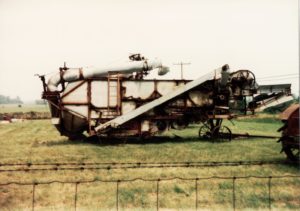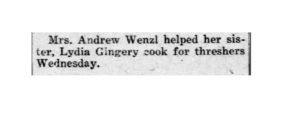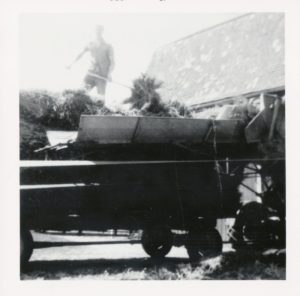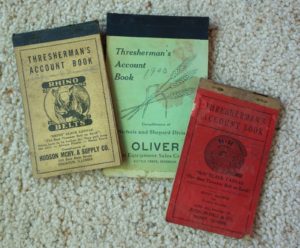We have several summer events coming up and we will have house-guests here, too, so I have been looking through my cookbooks and planning meals, preparing for more cooking than usual around here.
I remember my grandma saying, when preparing a large meal, that it was like cooking for threshers. Just the way she said that phrase gave me the impression that cooking for threshers was a whole lot of work.
I really didn’t understand or know much about threshing. I grew up in the country, but I did not grow up on a farm. There is a lot about farming I do not know. I don’t remember ever seeing threshing done, so I had to do some reading in order to understand it better and to learn what it had to do with cooking. Below is what I was able to piece together about threshing.
Threshing was a cooperative project among the farmers, to help each other during the wheat and oat harvest. Actually, this time of year would probably be the time for threshing. Quite a few people were involved in the threshing process, usually about 18-20 men on the threshing crew.
People first put the grain into sheaves and piled the sheaves together into shocks. The shocks would stand in the fields about two weeks or more before threshing. On threshing day there had to be enough people to haul the sheaves from the field and others who would toss the sheaves onto the conveyor that carried the sheaves into the threshing machine. There, in the threshing machine, the grain was separated from the chaff. Two men then sacked the grain and took it to the bins, where others piled up the sacks. More men were needed to build the stack from the leftover straw and chaff, which would be used for bedding for the livestock.
Long story short: the threshing machine removed the seeds from the stalks and husks.
The threshers worked hard and steady all day long.
And they worked up big appetites! This is where the term cooking for threshers comes in.
The farm family was responsible for feeding the threshers, although extended family and neighbors often helped with the meal. The threshing meal was the social part of the day, where people had a chance to gather, eat, and talk.
The threshing meal was a big event and could put quite a bit of pressure on a farm wife. A lot of thought and preparation went into the meal. I read that some women started worrying about the meal when the fields were planted in the spring.
These meals gave the women a chance to show off their cooking skills and set their table with special tablecloths and tableware. Women and girls were assigned to serve the food and often wore special aprons. The women and children ate only after the men were finished at the table.
Often neighboring women helped with the meal. Cooking for threshers sometimes made the news in the local newspaper:
Threshing was a lot of hard work for everyone.
My grandpa, Cornelius L. Schumm, had a threshing machine and he did threshing for other people.
Grandpa even saved a few of his threshing account books, between the years 1938-1946.
Next week I will post the names of the people grandpa did threshing for, as written in those books.








8 comments
Skip to comment form
Karen, do you have the “Willshire Community Civic Association Celebrating Ohio’s Bicentennial” cookbook among your collection? It included submitted personal “stories”, as well as recipes, and there is an interesting account submitted with some threshing pictures by Elodee Nye Marbaugh about when the threshing ring came to her grandparents’ farm. She details about the threshing, the big meal, and the Threshing Ring Celebration that followed the harvest season, where the community gathered for celebrating the end of the harvest season at a neighbor’s home with more food, homemade ice cream and desserts. There is even a picture of Elodee sitting on top of a straw stack behind her grandparents’ barn.
Author
I do have that cookbook and I just looked at the piece. What a great article and photo! I could have learned all about threshing and got my information from this! Thank you for the heads-up. I see that I need to look through this book much more closely.
Karen, I really enjoyed this article. My grandmother would often talk about feeding the threshers. I am not sure who it was but someone had a baby in the morning, went back to cooking so the meal would be ready on time. My how times have changed. the people from that time period were pretty amazing.
Author
My goodness! They certainly did take the threshing meal seriously! You are correct, I doubt many women would do that today. Thanks for writing!
I can remember well, my mother cooking for the ditching crews. She would break out the fine china..have fried chicken, mashed potatoes, etc….and a very special treat…fresh strawberries and Ice cream!!!!!!!
Author
From what I hear, ice cream was a very special treat back then! And, as far as I am concerned, still a special treat for me!
Loved yr article on “threshing” and cooking. My brother and I were recently remembering our Mother and her idioms. I reminded brother that during family get-togethers and holidays when we would all return to “the homestead” she would state that she’d been “cooking for thrashers” Her biggest meals for all of us. (She was a fantastic home chef!) Why she said thrashers instead of threshers, I don’t know. Her grandparents had a farm, but none of us kids ever stayed there or worked on it. Mother spent some summers there in the 1930’s as a young teen. We all grew up in Southern Ohio but in a whole different time of history and technology of course than our parents. I sent yr article to my brother and he will get a kick out of the history and information relayed therein.
Thanks and I will check yr website again!
Ellie
Author
It sounds like the “cooking for threshers” phrase was universally used. My grandmother may have pronounced it thrasher, too. I remember she said “worsh” instead of wash. Those were the good old days. Good memories. Thanks for writing and sharing your memories!